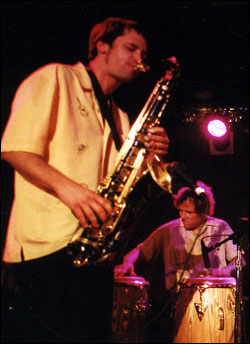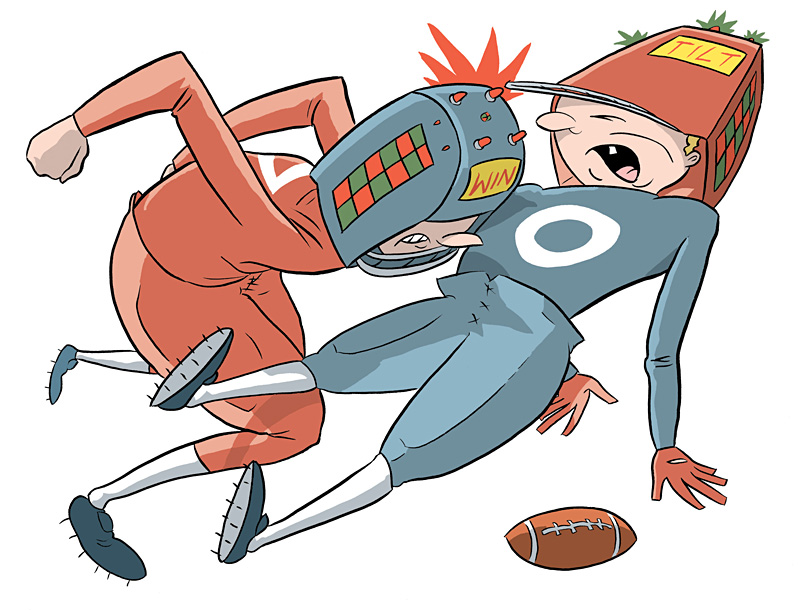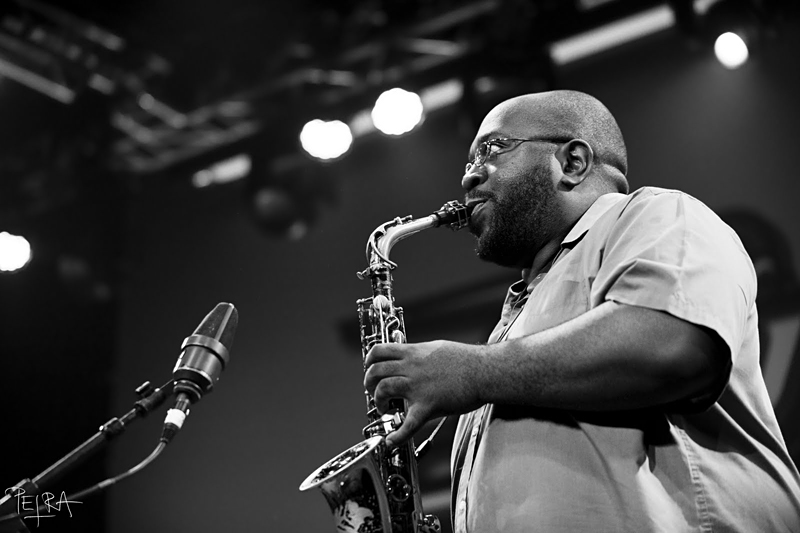It’s a sunless Sunday afternoon on the streets of West Seattle, and a string of capable, well-regarded jazz musicians are being listlessly received by a thin crowd of mostly older listeners. The atmosphere at the West Seattle Jazz Festivalto say nothing of the musicpresents little risk of anything genuinely original or surprising taking place. Then Skerik and the members of his Syncopated Taint Septet step up to the mainstage, and there’s an abrupt shift in mood.
Photographers are standing ready, and dozens of younger listeners have emerged and found their way to the curbside; there’s an actual feeling of expectation. From the opening notes of punk-funk clamor to the closing, sardonically crowd-pleasing, big-band medleyjoining Blakey’s “Moanin’,” Basie’s “Shiny Stockings,” and the Carpenters’ “Close to You”the septet brings a spirit of forward motion, style, and surprise that seems to be the very essence of jazz, even as it falls outside the jazz genres heard elsewhere that day. It’s not hard to understand why Earshot’s John Gilbreath exclaimed upon introducing the band, “They’re the hottest ticket in town!”
Skerik’s septet has some great playersincluding organist Joe Doria and drummer John Wicks (both veterans of Bebop and Destruction) plus four excellent hornsall of whom compose and arrange for the band and solo fiendishly. Yet there’s no mistaking the peculiar Skerik brand of no-borders enthusiasm that marks the septet’s sound; the band has his humor and dynamism writ large. Booked last week for the private opening of the new Triple Door club in the basement of Wild Ginger, the band was requested to please not play as wild as at their Bumbershoot show.
THE 38-YEAR-OLD saxophonist has helped stir an energized Seattle jazz fronta place where fat horns and gristly organs meet, where soul jazz is married to space rock and hard bop to hardcore, and all with traditional 1960s instrumentation, forgoing the easy update of screaming electric guitar. The sound is more historically minded than the typical jam band, but more creatively adventurous, too. Over the past decade, the scene has found perhaps its most accommodating home at the Owl and Thistle near Pioneer Squarelongtime ground zero for Bebop and Destruction, and where Skerik’s Syncopated Taint had a regular residency, too, recording a live CD for Ropeadope Records there one night last September.
“I love this place,” says Skerik, sipping a Coke in the dank, squalid splendor of the Owl on a recent afternoon. “It’s like your crazy uncle’s basementthat’s where you want to hang out, right?”
Known for his costumes and onstage antics, Skerik can be thoughtful and unassuming in person (“That stuff’s just at the show,” he says, “and four-fifths of music is not at the show”)rather like a jazz musician, though he shies away from that label as too confining . . . and too intimidating. “That’s a 12-hour a day, seven-day commitment,” he says. “Joe Henderson and those guys, they were monks. It’s kind of like ragas or something; there’s all these scales you have to know. You have, like, 300-500 standards, and you have to know them in all 12 keys. You can’t do anything else, you can’t be exploring different sonics and effects. You can’t be rocking out with your buddies. Everyone knows when someone’s fronting on it; you can’t hide with music like that. So there’s no way I would ever come out and say I was a jazz musician. I have too much respect. And there’s too many other styles of music in the world that I want to play.”
HE’S GETTING TO plenty of them. Skerik, who grew up on Mercer Island, first made a single name for himself as part of the power sound experimenters Critters Buggin’, a band whose theatrics rivaled its space jams, and which sporadically lives on, with a new disc coming this spring. In the years since, the saxophonist has had about as varied a career as anyone in town, joining or co-leading a slew of diverse bands with big names, here and around the country: the noise-mongers of Ponga with Wayne Horvitz; the swamp-funk solo projects of Primus leader Les Claypool and Galactic drummer Stanton Moore; the cinemascopic rock of Tuatara with Peter Buck and Screaming Trees drummer Barrett Martin; among others. My own favorite among his bands is Black Frames, a mostly mallet outfit in which the Critters Buggin’ crew wields multiple marimbas, joined by Texas percussionist Earl Harvin. They recently completed a Midwest tour.
The band we’ve come to discuss at the Owl is Garage a Trois, which spontaneously emerged five years ago from some in-studio, after-hours jams involving New Orleans drummer Stanton Moore and the renowned guitarist Charlie Hunter. Adding Critters Buggin’ percussionist Mike Dillon, the band released a record in April and is launching its first West Coast tour this week, including a stop at the Showbox on Sunday.
For Skerik, the band has been a multidimensional experience. “There’s no limitations,” he says. “Stanton can play anything; so can Charlie. It’s kind of scary. At the end of every tour, I definitely leave depressed ’cause I just got my ass kicked. Part of the band is high-tech instrumental prowess, and part is complete spur-of-the-moment party band. Charliehe’s just such a badass; he’s confident, in us and himself, to just show up and make the shit happen. It’s not a practical band. It’s just about the enthusiasm you have for music. It’s just playing your record collection. Every night is differentit’s like, ‘How do you feel tonight?’ ‘Man, I’m pissed off, I’m gonna turn up all this distortion, I’m gonna get all Melvins on these motherfuckers.’ Or the last tour, it was all about Bad Brains. Sometimes it’s all about Funkadelic.” That spontaneity is crucial to Skerik, of course. “I couldn’t just, like, have a set list, start a tour, and play it every day. I’d lose my mind.”
BUT THE OFF-THE-CUFF nature of the band is also a source of frustration for the saxophonist’s serious side. “I always wanted a band that would rehearse and play the most intense musical forms, but this band doesn’t want to go that way,” he says. “I thought we were really going to explore different kinds of harmonic possibilities in the organ trio tradition.” (Hunter approaches his guitar like an organ, playing bass lines along with chords and runs.) “I thought we were going to take Art Ensemble, Trouble Funk, and Larry Young and try to create some kind of new instrumental vocabulary. But I think, because it’s not anyone’s main gig, it ends up being like, ‘Hey man, this is a time to just get down and have some fun.'”
Unlike Skerik’s hometown five-horn septet, with Garage a Trois, he says, “We’re not forced to deal with five voices, scoring for all that harmony. We can always default to a 12-bar blues or a Hendrix tune.” Indeed, while the Garage a Trois disc, Emphasizer (Tone-Cool), offers some great, varied cuts with solos of density and shape, the band also has a tendency to just go balls out in a way that feels less cathartic than lazy.
But in Seattle, as in a few other cities, virtuosic piano trio the Bad Pluswhom some influential critics have deemed the future of jazzwill be playing the first set. Skerik says, “I think that’s going to inspire the guys to go deeper on stuff. It’s not like a rock band opening for you.” Spoken like a true, ahem, jazz musician.
Garage a Trois play the Showbox with the Bad Plus, 8 p.m. Sun., Sept. 28. $20 adv./$22.








